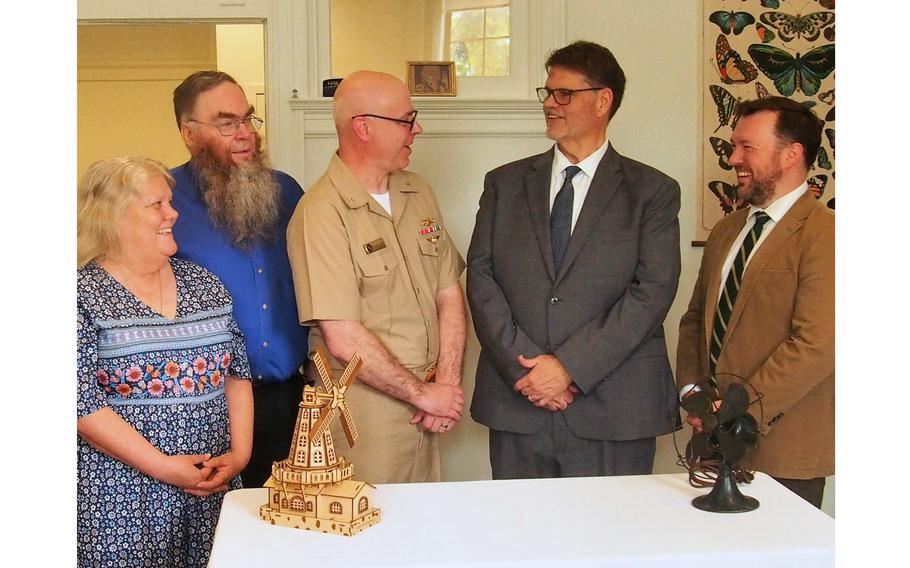
Distinguished guests at a commemoration for the 100th anniversary of one of the first demonstrations of television chat amongst themselves in Washington, June 13, 2025. From left: Gayle Fullerton, digital asset manager for the Naval Research Laboratory; James Snyder of the Society of Motion Picture & Television Engineers; Cmdr. David Lewis, Acting Head of Military Operations at the Naval Research Laboratory; Jim Moore of the U.S. Patent & Trademark Office; Smithsonian Institution historian and curator Ryan Lintelman. (Alexander Banerjee/Stars and Stripes)
WASHINGTON — A day before the U.S. Army celebrated its birthday in Washington, blocks away from the parade location, representatives from the Navy attended a small commemoration for a different kind of anniversary: 100 years since one of the first demonstrations of the technology that would become television, aided by the Navy.
The event in the district’s DuPont Circle neighborhood honored a June 13, 1925, demonstration of the broadcast of motion pictures that was held in the same building. The demonstration, led by inventor Charles F. Jenkins, was attended by the secretary of the Navy, the Naval Research Laboratory’s director of research and other government officials. Jenkins had assistance from the Navy in his experiments.
Just as Navy representatives attended the demonstration a century ago, service officials were present at the commemoration — and took a photo that re-created a picture of Jenkins taken in the same building.
Cmdr. David R. Lewis, Acting Head of Military Operations at the Naval Research Laboratory, told Stars and Stripes he saw the event as a commemoration of a past achievement, and something that resonates with the present, given the Navy’s active relationship with science and industry.
Though the military’s role in the technological breakthroughs of the internet and GPS is well known, the link between the Navy and Jenkins’ experiments is not.
Lewis and Gayle R. Fullerton, the research laboratory’s digital asset manager, said they were unaware of the service’s role in the innovation until recently.
Pete Hiotis, the owner of the historic property, learned of Jenkins’ presence there only after acquiring the place in 2016, according to Washingtonian Magazine. He has since sought to publicize the property’s history, and he wants to get the city to recognize it.
While it is certain that the Navy was in touch with Jenkins and lent a radio station for his experiments, Fullerton said they are still investigating whether he was also supported by Navy scientists. The Naval Research Laboratory’s then-director of research, Capt. Paul Foley, was present for the demonstration, according to a 1925 Washington Post article, but that is all that is confirmed.
One lesson worth drawing from the experiment, Lewis said, was the importance of connectivity and relationships.
“A lot of our science and technology development sometimes comes from unexpected places. And so it’s really important for us to be involved and be connected,” Lewis said.
“What makes NRL unique isn’t just the depth of our scientific expertise, but our longstanding partnerships with academia and industry across all facets of research and development,” he added via email.
The Navy connection included more than one demonstration
Jenkins’ experiments were just one part of a larger military-commercial alliance. The Radio Corporation of America was taken over by the federal government during World War I via the Navy, which acquired and operated private radio stations to reduce foreign control of the medium.
Similarly, Jenkins’ relationship with the Navy involved more than one experiment.
Two years before his 1925 success, Jenkins debuted the technology in a smaller demonstration, also in the Washington building, that was similarly attended by Navy representatives. The 1923 demonstration only entailed the transmission of images from a different room in the building.
The 1925 test, in contrast, featured a more distinguished audience and transmitted images from a Naval radio station several miles away in Maryland, which had been turned over to Jenkins for experimental purposes.
Jenkins had also used the station in a related experiment that transmitted still images to other cities in 1923, according to the contemporaneous Washington Post article.
Jenkins in 1926 also created a device that allowed ships at sea to receive images of weather maps. The technology was inaugurated at Naval radio station in Arlington, Va., and equipped on the Navy cruiser USS Trenton and transport vessel Kittery.
Other inventors in the 1920s had similar successes — a Scottish inventor even conducted a 1925 demonstration a few months before Jenkins in an event some would argue was the first public demonstration of television. But Jenkins’ earlier success in 1923 makes him a strong contender for the title of inventor of television. Jenkins also founded the first commercial TV station — then described as a radio movie broadcasting station — which operated out of the building that hosted the June 13 event.
After his 1923 success, Jenkins told the Evening Star (now defunct) that he predicted “radio motion pictures in the home” would soon become one of the most popular pastimes and would also be an “indispensable” factor “in times of war.”
Similarly, then-Navy Secretary Curtis Wilbur said at the 1925 demonstration, according to the Sunday Star, “I suppose we’ll be sitting at our desks during the next war and watching the battle in progress.”